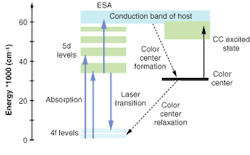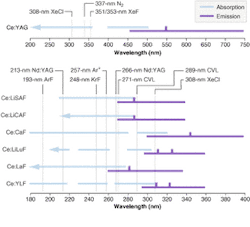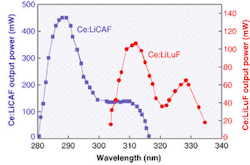Cerium lasers provide directly tunable ultraviolet light
A host of spectroscopic applications within fields such as atmospheric sensing and combustion diagnostics require tunable ultraviolet (UV) laser sources. Typically, outputs at such wavelengths are achieved via the relatively complex process of nonlinear frequency conversion of tunable visible and infrared lasers. A simpler and more efficient option is to use recently developed solid-state cerium-doped fluoride solid-state lasers, which produce tunable output directly in the 280- to 330-nm spectral region.
The prospect of realizing laser action in trivalent rare-earth-doped crystals based on 5d⇒4f transitions was first proposed about 30 years ago. The 5d⇒4f transition in triply ionized rare-earth ions is electric-dipole allowed, giving rise to large emission cross sections (up to 10–17 cm2) and radiative lifetimes on the order of a few tens of nanoseconds. This is in contrast to the 4f⇒4f transitions used in Nd:YAG lasers, which have very long lifetimes (hundreds of microseconds) and small emission cross sections (on the order of 10–19 cm2).
Cerium-doped laser action
Considerable effort has been made to realize UV and vacuum-UV (VUV) laser action in trivalent lanthanide-doped fluorides, such as cerium-doped yttrium lithium fluoride (Ce3+:YLF), neodymium-doped lanthanum fluoride (Nd3+:LaF3), and Nd3+:YLF. As yet, however, lasing has only been achieved in cerium-doped materials. The complex energy-level structure of the other trivalent lanthanides such as Nd3+, erbium (Er3+), and holmium (Ho3+) lead to large excited-state-absorption (ESA) cross sections which are greater than the emission cross sections. Thus, while many such materials make excellent scintillators, producing large amounts of UV/VUV fluorescence signal, they always produce net loss rather than net gain when pumped in the UV/VUV.
Trivalent cerium, the simplest rare-earth, has just one optically active electron, and therefore the fewest excited states for pump or laser photons to be absorbed via ESA (see Fig. 1). A wide-bandgap crystal host with good UV/VUV transmission is also required to ensure minimal excited-state absorption into the conduction band. For example, Ce3+:YAG exhibits such strong excited-state absorption into the conduction band that lasing is prevented. Fortunately, many fluoride crystals have the necessary wide bandgaps, leading to excellent deep-UV and VUV transmission, and so a variety of cerium-doped fluoride crystals have therefore been made to lase.
Depending on the crystal host, strong crystal-field splitting of the 5d levels leads to four or five broad absorption bands, the lowest of which forms the upper laser level. The lower laser level is the 4f level. This level is split by the spin orbit interaction into 2F5/2 and 2F7/2 levels, which weakly interact with the crystal field to form two bands. Cerium lasers are thus broadly tunable in the UV, with the host material determining the tuning ranges (see Fig. 2).
The three most important cerium-doped fluorides are lithium calcium aluminum fluoride, or Ce3+:LiCaAlF6 (Ce:LiCAF); lithium strontium aluminum fluoride, or Ce3+:LiSrAlF6 (Ce:LiSAF); and lithium lutetium fluoride, or Ce3+:LiLuF4 (Ce:LiLuF or Ce:LLF). These laser materials are considerably less affected by ESA and color-center effects than the earlier cerium lasers investigated, and have all been operated as lasers with high efficiency and wide tunability (see Fig. 3).
Like their chromium-doped infrared-laser counterparts, Ce:LiSAF and Ce:LiCAF are close analogs. Typically, Ce:LiCAF operates with higher efficiency (up to 46% slope efficiency) and broader tunability than Ce:LiSAF, although mixed-composition Ce:LiSrxCa1-xAlF6 crystals are being developed and show some promise. Cerium-doped LiCAF has a strong absorption band at 266 nm, and is therefore readily pumped by the fourth harmonic of Nd:YAG lasers, although sum-frequency-mixed copper-vapor lasers (271 nm) have also been used for high (10-kHz) pulse-rate operation. Tunability of Ce:LiCAF from 280 to 316 nm has been reported by several researchers, and output powers in excess of 600 mW have been obtained at 1 kHz from a commercial system developed by Lambda-Physik (Göttingen, Germany).
Cerium-doped LiLuF offers the opportunity to extend the tuning range of Ce:LiCAF to longer UV wavelengths (on the order of 330 nm); however, Ce:LiLuF does not have any absorption at 266 nm and thus cannot be pumped by the fourth harmonic of Nd lasers. While the fifth harmonic of Nd:YAG does overlap with an absorption band of LiLuF, to date pumping at 213 nm has been relatively inefficient (approximately 2%).There are, however, pump bands around 248 nm (suitable for krypton fluoride laser pumping), and around 290 nm. The 290-nm pump band can be accessed by the frequency-doubled yellow output of copper-vapor lasers, the output from a frequency-quadrupled Raman-shifted Nd:YAG laser, and even the free-running output of a Ce:LiCAF laser. All these pump sources have been used in various laboratories with considerable success. Slope efficiencies in excess of 65% have been recorded using a fourth-harmonic Raman-shifted Nd:YAG pump laser. Average powers of 380 mW and tunability from 305 to 334 nm have been reported using a 7-kHz frequency-doubled (289-nm) copper-vapor laser as the pump.
Cooling ensures efficiency, tunability
Cerium-doped LiLuF exhibits interesting gain-competition effects between the sigma and pi polarizations when operated at the long-wavelength peak of the tuning curve around 327 nm, with sigma polarization having higher gain but also higher excited-state absorption, and hence low efficiency. Cooling of Ce:LiLuF, together with suppression of sigma-polarized lasing, can ensure operation with high efficiency and continuous tunability.
Further wavelength extension has been demonstrated by sum-frequency mixing tunable cerium-laser output with the Nd:YAG 1.064-µm line to obtain wavelength coverage from 223 to 243 nm. A group led by Richard Moncorge at the Université de Caen (Caen, France) has generated Stokes and anti-Stokes lines by Raman shifting in a 20-cm molecular hydrogen cell. This has extended the tunability from 285 nm to the visible. Narrow-linewidth distributed-feedback operation has been obtained in Ce:LiSAF, producing up to 80 µJ of 290-nm output with a bandwidth of less than 1 Å. Likewise, with use of an intracavity etalon and multiple-prism beam expander, up to 130 mW of 290-nm, 12.5-GHz-linewidth Ce:LiCAF output has been produced.
Several subnanosecond single-pulse and pulse-train-generation techniques have been developed, based on short (less than a few centimeters) cavities. Up to 14 mJ of single-pulse 289-nm Ce:LiCAF output has been generated from such a configuration with use of an additional power amplifier.
Cerium-doped LiCAF and LiLuF have sufficient gain bandwidth to support femtosecond pulse generation and amplification. In Japan and elsewhere, considerable effort is going into developing cerium lasers as power amplifiers for femtosecond pulsed-UV lasers. In the Fukuda Laboratory (Chiba, Japan), growth of large (70-mm-diameter) Ce:LiCAF and Ce:LiLuF crystals has been perfected. Using these large-aperture crystals, chirped-pulse amplification of femtosecond pulses in a four-pass Ce:LiCAF bowtie-style amplifier (gain of 370) was demonstrated, in which 6-mJ pulses were derived that could be compressed to 115 fs following dispersion compensation.
With the advent of Ce:LiCAF, Ce:LiSAF, and Ce:LiLuF, the excellent performance characteristics of approximately 300-nm-tunable cerium lasers (including better than 60% slope efficiencies, 280- to316-nm tunability, and 60-mJ pulse energies) now rival or exceed those of 2ω dye and 3w tunable infrared solid-state lasers, without the complication of a final nonlinear frequency-conversion stage. As a consequence, cerium lasers have begun to find application in areas such as combustion diagnostics and lidar. A Ce:LiCAF laser was brought to market by Lambda-Physik as a replacement technology for frequency-doubled dye-laser UV applications.
Continuous-wave possibility
Despite these advances, cerium lasers have yet to receive the recognition they merit, especially for UV spectroscopic applications, to which they are highly suited. Currently unexplored avenues of investigation include attempts to realize continuous-wave cerium lasers and ultrashort-pulse generation using modelocked Ce:LiSAF, especially given the infrared modelocking capability of Cr:LiSAF, and that the 35-nm gain bandwidth of Ce:LiSAF is theoretically capable of supporting 10-fs pulses.
Cerium lasers have been described as the Ti:sapphire of the UV and are in a similar stage of development to Ti:sapphire in the late 1980s. For many years, cerium laser technology was held back by a lack of suitable all-solid-state pump sources. The technology for all-solid-state deep-UV generation based on harmonic conversion of Nd:YAG lasers is constantly improving as industrial demand for these lasers continues to grow. This can only be good news for cerium lasers, which provide a natural path to tunable UV in the 280- to 330-nm spectral region.
ANDREW J.S. McGONIGLE is a postdoctoral research fellow with the Department of Geography, University of Cambridge, Cambridge, CB2 3EN, England; e-mail: [email protected]. DAVID W. COUTTS is a senior lecturer in the Centre for Lasers and Applications, Department of Physics, ICS, Macquarie University, 2109, Australia; e-mail: [email protected].



